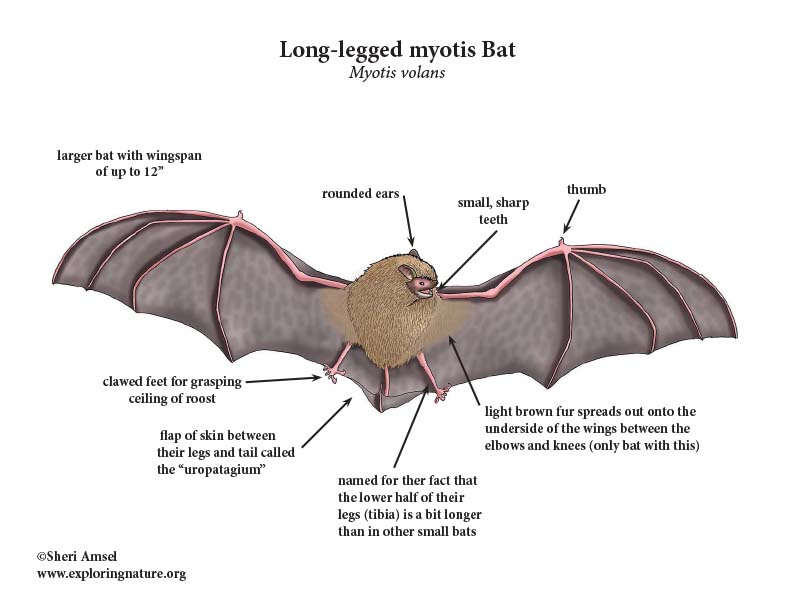

They live in the western North America from southern Alaska and southwestern Canada, through the western U.S. to western-central Mexico.
They are found in mountainous areas in a range of forest habitats, though have been identified in open meadows and even desert habitats.
One of the larger North American bats, the long-legged myotis can have a wingspan of up to a foot wide, though they still weigh in at less than half an ounce. They have rounded ears. The lower half of their legs (tibia) is a bit longer than in other small bats - giving them their name and their feet are small. Their fur is light brown and, unlike any other species of North American bat, spreads out onto the underside of the wings between the elbows and knees. This trait, helps scientists identify them in the field.
They come out at sunset to hunt for moths using echolocation. During the day, they roost in cracks in rocks, under the bark of trees, or in abandoned building or caves, where available. In the winter, they move to lower elevations and hibernate underground in mines or caves.
They eats insects – mostly moths.
Females gather in large breeding colonies in the trees, in the spring and give birth to a single baby (pup) between June - August. During the night, when they are out feeding, they leave their pups in the colony and come back to nurse on and off all night. Males do not help with young.
They have been affected by white-nose syndrome, a deadly fungal disease that has hurt so many North American bat species. Though they are listed on the IUCN Red list as "least concern" the fungal disease may affect their long term populations.
Related Resources:
Coloring Page
Labeling Page
High Resolution Diagram
Kingdom: Animalia
Phylum: Chordata
Class: Mammalia
Order: Chiroptera
Family: Vespertilionidae
Genus: Myotis
Species: M. volans
When you research information you must cite the reference. Citing for websites is different from citing from books, magazines and periodicals. The style of citing shown here is from the MLA Style Citations (Modern Language Association).
When citing a WEBSITE the general format is as follows.
Author Last Name, First Name(s). "Title: Subtitle of Part of Web Page, if appropriate." Title: Subtitle: Section of Page if appropriate. Sponsoring/Publishing Agency, If Given. Additional significant descriptive information. Date of Electronic Publication or other Date, such as Last Updated. Day Month Year of access < URL >.
Amsel, Sheri. "Bat (Long-legged Myotis)" Exploring Nature Educational Resource ©2005-2024. December 14, 2024
< http://www.exploringnature.org/db/view/Long-legged-myotis >

